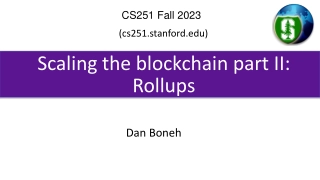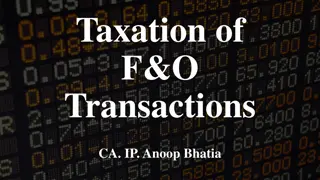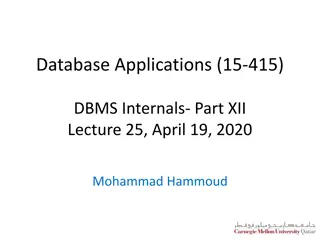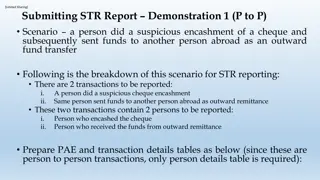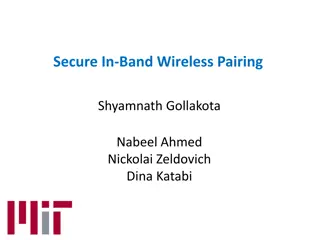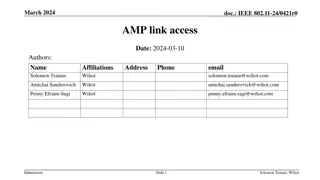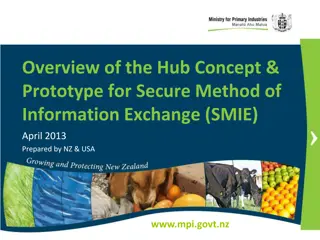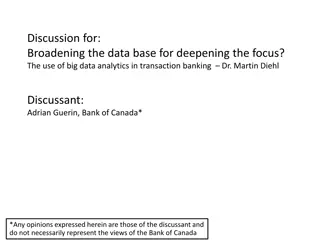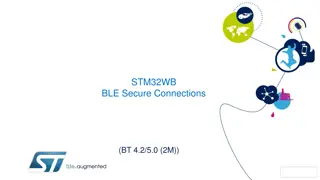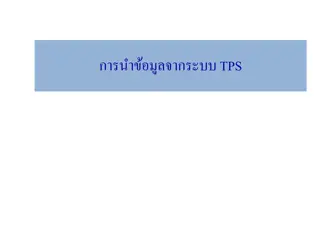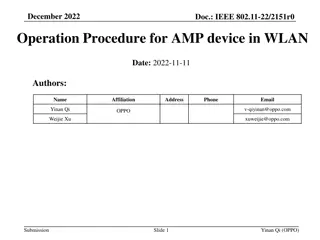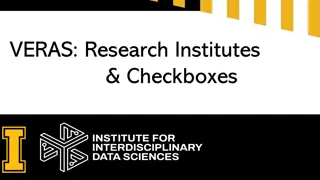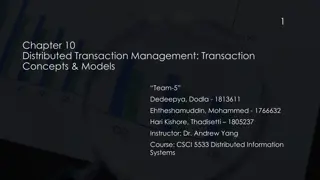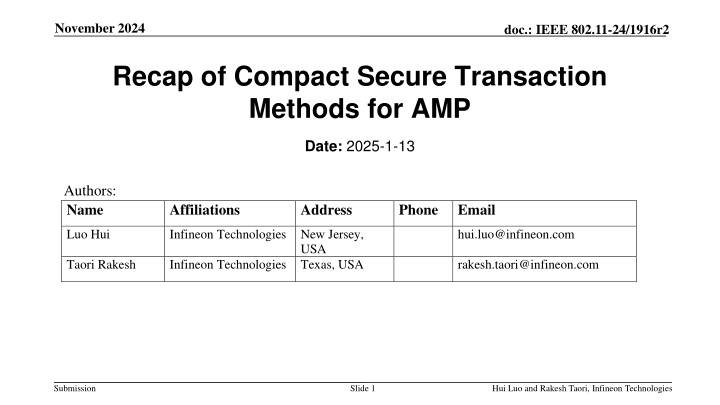
Compact Secure Transaction Methods for AMP Devices
Explore IEEE 802.11-24/1916r2's recap of secure transaction methods for AMP devices, focusing on SAE-based methods, shared secret-based transactions, server-managed methods, and more. Learn about the energy-efficient and privacy-conscious approaches for secure data exchanges in wireless communication.
Uploaded on | 0 Views
Download Presentation

Please find below an Image/Link to download the presentation.
The content on the website is provided AS IS for your information and personal use only. It may not be sold, licensed, or shared on other websites without obtaining consent from the author. If you encounter any issues during the download, it is possible that the publisher has removed the file from their server.
You are allowed to download the files provided on this website for personal or commercial use, subject to the condition that they are used lawfully. All files are the property of their respective owners.
The content on the website is provided AS IS for your information and personal use only. It may not be sold, licensed, or shared on other websites without obtaining consent from the author.
E N D
Presentation Transcript
November 2024 doc.: IEEE 802.11-24/1916r2 Recap of Compact Secure Transaction Methods for AMP Date: 2025-1-13 Authors: Name Affiliations Address Phone Email Luo Hui Infineon Technologies New Jersey, hui.luo@infineon.com USA Taori Rakesh Infineon Technologies Texas, USA rakesh.taori@infineon.com Submission Slide 1 Hui Luo and Rakesh Taori, Infineon Technologies
November 2024 doc.: IEEE 802.11-24/1916r2 A Re-Cap of Secure Transaction Methods This re-cap focuses on principle, applicability, estimated message size, and estimated energy consumption, instead of details for each methods. SAE-based (SAE authentication based on shared secret, Ascon/AES128 for encryption/decryption) 11-24/0178, a shared secret-based secure transaction method (for active UL TX AMP, legacy preamp AMP). 11-24/0526, a server-managed secure transaction method (for active UL TX AMP, legacy preamp AMP). 11-24/0871, AMP device-initiated secure transaction methods (for legacy preamp AMP). 4-way handshake based (keyed hash authentication based on high-entropy shared secret, Ascon/AES128 for encryption/decryption) 11-24/1998, Secure Transaction Methods with Low Computation Complexity for AMP Devices. Privacy at minimum cost (random MAC addresses and hashed device IDs, 0.018uJ per 32B by SHA256, see [9]). 11-24/1242, AMP Secure Transaction Methods Using Random MAC Address for Privacy. Submission Slide 2 Hui Luo and Rakesh Taori, Infineon Technologies
November 2024 doc.: IEEE 802.11-24/1916r2 Recap: why transaction methods? 802.11 security protocol such as WPA3 SAE defines 10+ frame exchanges to setup a secure link (security association) between two STAs, requiring the STAs to maintain the secure link, which consumes energy that may not be affordable by power-constrained AMP devices. Even tearing down a secure link has complicated details. Secure links are designed to support multiple applications running on STAs, possibly with large data volume over a long period. AMP devices are most likely designed for single purposes and very likely exchange small amount of data for every communication (called a transaction). SAE-based secure transaction methods: 3-4 frame exchanges for mutual authentication, key generation, and 1st encrypted data exchange. 4-way handshake-based secure transaction methods: 2 frame exchanges for AMP authentication, key generation, 1st encrypted UL data transfer. 4 frame exchanges for mutual authentication, key generation, 1st encrypted data exchange. Secure transaction methods can co-exist with 802.11 secure link method Submission Slide 3 Hui Luo and Rakesh Taori, Infineon Technologies
November 2024 doc.: IEEE 802.11-24/1916r2 SAE-based secure transaction methods 3-4 frame exchanges for mutual authentication, key generation, 1st encrypted and authenticated data exchange. 2 frame exchanges for subsequent encrypted and authenticated data exchanges until an AMP device can (or has to) power down. SAE authentication based on a shared secret (not necessarily high-entropy, easier provisioning). Encryption algorithm: Ascon or AES128 GCM (0.28uJ/0.98uJ per 16B block by ASCON/AES128). Message sizes <= 160 bytes. Suitable for AMP devices with slightly more computation power for SAE authentication, such as those capable of active UL transmission and those capable of transmitting legacy preamp. Submission Slide 4 Hui Luo and Rakesh Taori, Infineon Technologies
November 2024 doc.: IEEE 802.11-24/1916r2 A shared secret-based secure transaction method for AMP devices Assumptions AMP devices typically support one application (function). AMP devices do not have large data volume to exchange at each transaction. AMP devices do not need to maintain association and/or low power mode (they can simply power off or lose the power after communication). Key ideas A simple Request (by regular STA) + Response (by AMP device) transaction model. Integrated security based on a shared secret between the requester (regular STA) and the respondent (AMP device). Absolutely minimize exchanged messages. Highlights 4 frame exchanges are needed to finish secure transaction. 32B DL, 96B UL, 128B DL, 64B UL 16B (assuming minimum data) Submission Slide 5 Hui Luo and Rakesh Taori, Infineon Technologies
November 2024 doc.: IEEE 802.11-24/1916r2 A server-managed secure transaction method for AMP devices Use case An entity owning many deployed AMP devices may want to dynamically allow/disallow reading devices to access deployed AMP devices. Example: a contractor s reading device may need the access, and the access right should be removed after finishing the contract. Shared secret between a reading device and an AMP device is no longer suitable. It is impractical to maintain and update identifiers and shared secrets for different reading devices on every AMP device, especially deployed AMP devices. Let a server manage access rights dynamically without touching deployed AMP devices. Highlights 4 frame exchanges. 32B DL, 160B UL, 128B DL, 64B DL (assume minimum data). 16B Submission Slide 6 Hui Luo and Rakesh Taori, Infineon Technologies
November 2024 doc.: IEEE 802.11-24/1916r2 A shared secret-based AMP device-initiated secure transaction method (for legacy preamp AMP) Use case The AMP device could be a glass breaking sensor, must initiate the communication to report an alarm. Assumptions The Wi-Fi reading device and the AMP device share a secret code, which is the foundation of the secure transaction. The AMP device can afford the energy of repeatedly sending a complicated Init_Request message until the message is detected by the reading device. Highlights 3 frame exchanges are needed to finish mutual authentication and encrypted data exchange. 96B UL, 128 DL, 64B UL 16B (assuming minimum data) Submission Slide 7 Hui Luo and Rakesh Taori, Infineon Technologies
November 2024 doc.: IEEE 802.11-24/1916r2 A server-managed AMP device-initiated secure transaction method (for legacy preamp AMP) Use case An entity (e.g., a mall) owning many deployed AMP sensors may want to dynamically allow/disallow reading devices (e.g., stores reading devices) to access those AMP devices based on contract terms, without changing anything in the deployed AMP devices. Assumptions The owner s server and every AMP device share a secret code, which is the foundation of the secure transaction. The reading device cannot know the secret code. Every reading device has a user id and a credential managed by the server. The server determines if a reading device can access any AMP device based on such information. Highlights 3 frame exchanges. 160B UL, 128B DL, 64B UL minimum data) 16B (assuming Submission Slide 8 Hui Luo and Rakesh Taori, Infineon Technologies
November 2024 doc.: IEEE 802.11-24/1916r2 A shared secret-based reading device-initiated secure transaction method with privacy Assumptions A reading device R and an AMP device A has a shared secret. A has a confidential name A_ID. R knows A_ID. Solution R sends the hash value of A_ID in ID_Request using random address R1 as source address and broadcast address as destination address. Every AMP device near R receives ID_Request and computes the hash value using its own name. Only A finds the computed hash value matches the received hash value. A sends back ID_Response using random address R2 as source address and R1 as destination address. R and A follow the shared secret-based reading device-initiated secure transaction method to finish the communication, with R1 and R2 as their MAC addresses. Highlights 4 frame exchanges to finish secure transaction with privacy. 96B DL, 160B UL, 128B DL, 64B UL 16B (assuming minimum data) Submission Slide 9 Hui Luo and Rakesh Taori, Infineon Technologies
November 2024 doc.: IEEE 802.11-24/1916r2 A server-managed reading device-initiated secure transaction method with privacy Assumptions A server S owns many deployed AMP devices, including A. S and A shares a secret. A has a confidential name A_ID. A reading device R has registered on S with R_ID and R_credential. S manages whether R can access A based on such registered information. R knows A_ID. Solution R sends the hash value of A_ID in ID_Request using random address R1 as source address and broadcast address as destination address. Every AMP device near R receives ID_Request and computes the hash value using its own name. Only A finds the computed hash value matches the received hash value. A sends back ID_Response using random address R2 as source address and R1 as destination address. R and A follow the server-managed reading device-initiated secure transaction method to finish the communication using R1 and R2 as their MAC addresses. Highlights 4 frame exchanges 96B DL, 160B UL, 128B DL, 64B UL minimum data) 16B (assuming Submission Slide 10 Hui Luo and Rakesh Taori, Infineon Technologies
November 2024 doc.: IEEE 802.11-24/1916r2 A shared secret-based AMP device-initiated secure transaction method with privacy (for legacy preamp AMP) Assumptions A reading device R and an AMP device A has a shared secret. A has a confidential name A_ID. R knows A_ID. A may has R s public key if R has share secrets with a lot of AMP devices (otherwise it is not needed). Protocol A sends Init_Request with A_ID encrypted using R s public key or hashed, using a random address R1 as source address and a broadcast address as destination address. Every reading device near A tries to decrypt A_ID or matches the hashed value using AMP device names stored in memory. Only R can decrypt A_ID or find the match. R then sends Data_Request using a random address R2 as source address and R1 as destination address. R and A follow the shared secret-based AMP device-initiated secure transaction method to finish the communication, with R2 and R1 as their MAC address. Highlights 3 frame exchanges 160B UL, 128B DL, 64B UL 16B (assuming minimum data) Submission Slide 11 Hui Luo and Rakesh Taori, Infineon Technologies
November 2024 doc.: IEEE 802.11-24/1916r2 A server-managed AMP device-initiated secure transaction method with privacy (for legacy preamp AMP) Assumptions A server S identified as S_URL owns many deployed AMP devices, including A. A stores S_URL and S s public key in its non-volatile memory. S and A shares a secret. A has a confidential name A_ID. A reading device R has registered on S with R_ID and R_credential. S manages whether R can access A. R does not know A_ID. Protocol A sends Init_Request with a session_id, S_URL, and A_ID encrypted using S s public key, using a random address R1 as source address and a broadcast address as destination address. Every reading device near A and registering on S forwards the content of Init_Request to S. S only responds to the first reading device based on session_id, assuming it is R without loss of generality. S decrypts A_ID, generates security parameters needed by Data_Request based on the secret shared with A, and sends the parameters to R. R then sends Data_Request using a random address R2 as source address and R1 as destination address. R and A follow the server-managed AMP device-initiated secure transaction method to finish the communication, with R2 and R1 as their MAC address. Highlights 160B UL, 128B DL, 64B UL 16B (assuming minimum data) Submission Slide 12 Hui Luo and Rakesh Taori, Infineon Technologies
November 2024 doc.: IEEE 802.11-24/1916r2 4-way handshake-based secure transaction methods 2 frame exchanges for AMP authentication, key generation, 1st encrypted and authenticated UL data transfer (for read-only AMP devices). 4 frame exchanges for mutual authentication, key generation, 1st encrypted and authenticated data exchange. 2 frame exchanges for subsequent encrypted and authenticated data exchanges until AMP device can (or has to) power down. 4-way handshake authentication based on a shared high-entropy secret, i.e., PMK or equivalent (against offline brute-forcing/dictionary attacks). Encryption algorithm: Ascon or AES128 GCM (0.28uJ/0.98uJ per 16B block by ASCON/AES128). Message sizes <= 80 bytes (if using AEAD for message integrity) or 96 bytes (if using MIC). Suitable for all types of AMP devices because authentication only uses hash functions (0.018uJ per 32B by SHA256). Submission Slide 13 Hui Luo and Rakesh Taori, Infineon Technologies
November 2024 doc.: IEEE 802.11-24/1916r2 A high-entropy shared secret-based secure transaction method for single- purpose read-only AMP devices Assumptions A reading device R and an ambient device A share a high-entropy secret P. A has a secret ID (A_ID) known by R. DL data does not need encryption. Its sole purpose is to enable the AMP device to transmit/backscatter the same type of UL data (A is a read-only, single- purpose device). Protocol highlights Privacy (random MAC address for R and A) Only one round-trip frame exchange (DL then UL), then A can power off. R-to-A authentication not needed as A is single-purpose and read-only. A-to-R authentication is assured by A s capability of generating the same key K and producing an authentication code (by AEAD or MIC) verifiable by R. Complexity 64B DL, 80B UL, 16B (assuming minimum 16B data). 2 hash calculations, 5 encryption blocks by A. 1.4uJ/4.9uJ if authentication by ASCON/AES AEAD, or 0.6uJ/2.0uJ with an extra 16B MIC. Submission Slide 14 Hui Luo and Rakesh Taori, Infineon Technologies
November 2024 doc.: IEEE 802.11-24/1916r2 A high-entropy shared secret-based secure transaction method for AMP devices that can keep memory for 2 or more UL transmission/backscattering Assumptions A reading device R and an ambient device A share a high-entropy secret P. A has a secret ID (A_ID) known by R. A can keep memory alive for 2 or more UL transmission/backscattering. A may not be single-purpose, read-only device, so both DL data and UL data need to be encrypted. Protocol highlights Privacy (random MAC address for R and A). Mutual authentication. A seamless extension of the one-cycle security protocol: A can send UL data in multiple transmission/backscattering (N+1 round-trip frame exchanges if A needs to transmit/backscatter N UL data frames). Complexity 64B DL, 80B UL, 80B DL, 64B UL 16B (assuming minimum 16B data). 2/3 hash calculations if authentication by AEAD/MIC, 14 encryption blocks by A. 3.9uJ/13.7uJ if authentication by ASCON/AES AEAD, or 1.2uJ/4.0uJ with an extra 16B MIC. Submission Slide 15 Hui Luo and Rakesh Taori, Infineon Technologies
November 2024 doc.: IEEE 802.11-24/1916r2 A server-managed secure transaction method for single-purpose read-only AMP devices Assumptions An ambient device A and a server S share a high-entropy secret P. S manages whether a reading device R can read data from A based on R_ID and R_credential. A has a secret ID (A_ID) known by R. The server s URL (S_URL) is also known by R. DL data does not need encryption. Its sole purpose is to enable the AMP device to transmit/backscatter UL data (A is a read-only, single-purpose device). Protocol highlights Privacy (random MAC address for R and A) Only one round-trip frame exchange (DL then UL), then A can power off. No server access delay. R-to-A authentication not needed as A is single-purpose and read-only. A-to-R authentication is assured by A s capability of generating the same key K and producing an authentication code (by AEAD or MIC) verifiable by S. Complexity 64B DL, 80B UL, 16B (assuming minimum 16B data). 2 hash calculations, 5 encryption blocks by A. 1.4uJ/4.9uJ if authentication by ASCON/AES AEAD, or 0.6uJ/2.0uJ with an extra 16B MIC. Submission Slide 16 Hui Luo and Rakesh Taori, Infineon Technologies
November 2024 doc.: IEEE 802.11-24/1916r2 A server-managed secure transaction method for AMP devices that can keep memory for 2 or more UL transmission/backscattering Assumptions An ambient device A and a server S share a high-entropy secret P. S manages whether a reading device R can read data from A based on R_ID and R_credential. A has a secret ID (A_ID) known by R. The server s URL (S_URL) is also known by R. A can keep memory alive for 2 or more UL transmission/backscattering. A may not be single-purpose, read-only device, so both DL data and UL data need to be encrypted. Protocol highlights Privacy (random MAC address for R and A). Mutual authentication. Only R-to-A authentication is subject to one-time server access delay. A seamless extension of the server-managed one-cycle security protocol: A can send UL data in multiple transmission/backscattering without server access delay (N+1 round-trip frame exchanges if A needs to transmit/backscatter N UL data frames). Complexity 64B DL, 80B UL, 80B DL, 64B UL 16B (assuming minimum 16B data). 2/3 hash calculations if authentication by AEAD/MIC, 14 encryption blocks by A. 3.9uJ/13.7uJ if authentication by ASCON/AES AEAD, or 1.2uJ/4.0uJ with an extra 16B MIC. Submission Slide 17 Hui Luo and Rakesh Taori, Infineon Technologies
November 2024 doc.: IEEE 802.11-24/1916r2 Straw poll 1 Do you agree to insert the following text in the security sub-clause of the SFD? IEEE 802.11bp will specify secure data communication methods that do not require maintaining security associations. Note: The methods will be based on existing 802.11 security protocols. The methods will coexist with existing 802.11 security protocols for 11bp devices capable of maintaining security associations. The details are TBD. Submission Slide 18 Hui Luo and Rakesh Taori, Infineon Technologies
November 2024 doc.: IEEE 802.11-24/1916r2 A Re-Cap of ASCON 11-24/1584, Ascon: The Lightweight Cryptography As A Better Cipher Than AES 128 for 802.11bp (same security performance as AES128 GSM, faster and <1/3 energy consumption). NIST published the initial draft standard for constrained devices based on Ascon (NIST SP 800- 232 on Nov 8, 2024. 802.15 adopted Ascon as a cipher method in IEEE 802 Nov. 24 meeting. Ballpark energy estimation: 0.28uJ/0.98uJ per 16B block by ASCON/AES128. Submission Slide 19 Hui Luo and Rakesh Taori, Infineon Technologies
November 2024 doc.: IEEE 802.11-24/1916r2 Straw poll 2 Do you agree to insert the following text in the security sub-clause of the SFD? IEEE 802.11bp will specify ASCON-128 as an optional cipher for 802.11bp STAs. IEEE 802.11bp will specify BIP-ASCON-128 as an optional authentication-only cipher for 802.11bp STAs. Submission Slide 20 Hui Luo, Rakesh Taori, Florian Mendel, Martin Schl effer, Infineon Technologies
November 2024 doc.: IEEE 802.11-24/1916r2 Reference 1. Meltem Sonmez Turan, Kerry McKay, Donghoon Chang, Lawrence E. Bassham, Jinkeon Kang, Noah D. Waller, John M. Kelsey, Deukjo Hong, NIST Internal Report 8454: Status Report on the Final Round of the NIST Lightweight Cryptography Standardization Process , June 2023, https://nvlpubs.nist.gov/nistpubs/ir/2023/NIST.IR.8454.pdf. Christoph Dobraunig, Maria Eichlseder, Florian Mendel, Martin Schlaeffer, ASCON v1.2 Submission to NIST , May 31, 2021. Sebastian Renner, Enrico Pozzobon, and Jurgen Mottok, The Final Round: Benchmarking NIST LWC Ciphers on Microcontrollers , 2022, https://link.springer.com/chapter/10.1007/978-3-031-21311-3_1 Mark D. Aagaard, Nusa Zidaric, ASIC Benchmarking of Round 2 Candidates in the NIST Lightweight Cryptography Standardization Process , 2021, https://eprint.iacr.org/2021/049.pdf Joerg Robert, Clemens Korn, Power Consumption Calculation , doc: IEEE 802.11-23/1232r0, July 11, 2023. Luke E. Kane, Jiaming James Chen, Rebecca Thomas, Vicky Liu, Matthew McKague, Security and Performance in IoT: A Balancing Act , IEEE Access, vol. 8, pp. 121969-121986, July 6, 2020. Levent Ertaul, Anup Mudan, Nausheen Sarfaraz, Performance Comparison of AES-CCM and AES-GCM Authenticated Encryption Methods , 2018, https://mcs.csueastbay.edu/~lertaul/AESCCMCAMREADY.pdf Bekbolat Medetov, Tansaule Serikov, Aray Tolegenova, Zhexebay Dauren, Comparative Analysis of the Performance of Generating Cryptograhic Ciphers on CPU and FPGA, 2022, https://www.jatit.org/volumes/Vol100No15/24Vol100No15.pdf B. Kieu-Do-Nguyen, T. -T. Hoang, C. -K. Pham and C. Pham-Quoc, "A Power-efficient Implementation of SHA-256 Hash Function for Embedded Applications," 2021 International Conference on Advanced Technologies for Communications (ATC), Ho Chi Minh City, Vietnam, 2021, pp. 39-44, doi: 10.1109/ATC52653.2021.9598264. 2. 3. 4. 5. 6. 7. 8. 9. Submission Slide 21 Hui Luo and Rakesh Taori, Infineon Technologies

